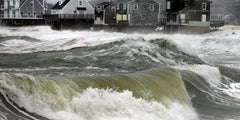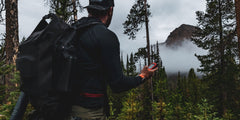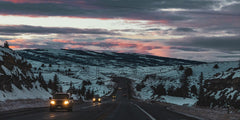Purifying and Filtering Water: What's the Difference and How to do it Right
February 21, 2023 | Brian Warren
Giardia, Montezuma’s Revenge, Beaver Fever, The Hershey Squirts… and worse.
Nobody wants anything to do with a stomach bug caused by bad drinking water. But what is the safest approach? How safe do you really have to be?
Well, pour yourself a nice glass of water from your faucet and read on…
The United States has one of the safest drinking water supplies in the world. Despite this, over 7 million people get sick from diseases spread through water each year. My general rule is ‘better safe than sorry’.

The first thing is to define what we’re talking about. Often times, the words purify and filter are interchanged. And while they have similarities, there are some large - and important - differences:
PURIFYING vs FILTERING
In the end, purifying does more than filtering. Filtering removes protozoa and bacteria, where purifying removes protozoa, bacteria AND viruses. Fortunately, viruses are only present in less-developed areas of the world, so for North America, filtering water is a safe solution.
HOW TO PURIFY
When it comes to purifying water, there are three ways to purify water:
-
Boiling - bring the water to a rolling boil for 3-5 minutes.
-
Disinfect - add 16 drops of household liquid bleach (only) per gallon of water, stir and let stand for 30 minutes.
-
Distillation - Fill a pot halfway with water. Tie a cup to the handle on the pot’s lid so that the cup will hang right side up when the lid is upside-down. Make sure the cup is not dangling in the water. Boil the water for 20 minutes. The water that drips from the lid to the cup is distilled.
Each of these techniques will provide safe drinking water. But they also may not be the most effective when it comes to time and gear, and frankly, it’s just not needed unless you’re in some extremely under developed third-world countries.
FILTERING
So, as long as you’re exploring in North America, Europe, etc, filtering is just fine.
How to filter? Well, this one is pretty simple, and it mostly comes down to what you’re up to. Things like weight, packability, flow rate and more are likely considerations based upon how far you’re going, and with how many.

Water filters do just that - they filter - by forcing water through cartridges with tiny pores that allow water to pass through, but prevent the protozoa and bacteria to do the same. This also clears out all the debris and dirt you may find while sourcing water from a stream or puddle.
HOW TO FILTER
Our favorite types are those which pack light, and get the job done quickly. We include a Sawyer Mini in each survival kit we sell for this exact reason. We like this filter over a life straw because it allows you to filter water later (you can fill a container and filter at a later time), it allows you to fill bottles or other carrying vessels, where a Lifestraw is basically filtering the water you can drink in the moment. These types of filters are also TINY. I carry one in my bike jersey when I’m on a long cycle through the mountains.

If you’re going on a longer adventure, or have multiple people with, and maybe weight isn’t as much of a factor, a pump or gravity filter is a great option. These will purify more water given a higher flow rate, and work better for filling multiple vessels. But they do come at a size and weight premium.
WHAT ABOUT BOILING?
Yes, boiling is an effective way to purify water. That said, it’s costly when it comes to fuel, time and the tools required. I wouldn’t recommend this technique unless you’re in a winter environment and have to melt snow for drinking water anyways. If you’re going to do it, make sure you bring water to a boil for 3 minutes to be safe!

MAINTENANCE
One of the biggest mistakes is not cleaning your filter after use. Don’t leave dirty water in your filter - it can contaminate, freeze and expand the holes in the filter and do a variety of things that can compromise your tools. But in stead of getting too specific here, just promise me you’ll read and follow your instruction manual, ok?





